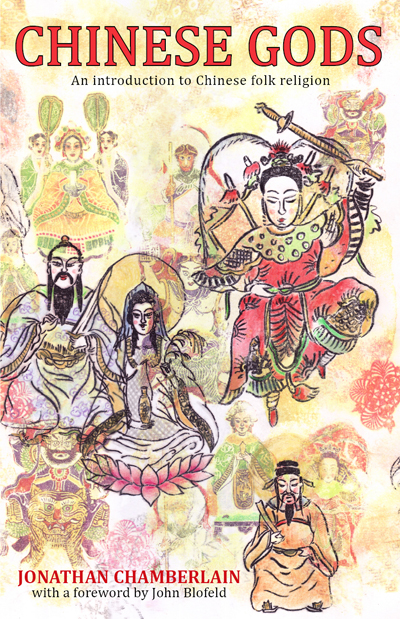For the uncountable numbers of overseas visitors who visit Chinese temples and puzzle over the carvings of fierce and gentle deities, or for those who wonder just who is being venerated in the small shrine at the back of a Chinese restaurant, this is a little gem of a book.

Irishman Jonathan Chamberlain began writing about Chinese folk religion when living in Hong Kong twenty years ago. Chinese Gods developed out of his passion for collecting glass devotional paintings that were still being produced in large numbers at the time. Originally attracted by the vivid images (the book includes 22 color plates) he soon began to wonder what they represented. From his Chinese girlfriend, now his wife, from worshipers, and from the few existing works on the subject, he began to piece together the story of the thousands of major and minor gods that make up the Chinese pantheon.
Some are Buddhist figures imported from India, often transmuted on the way to suit Chinese taste and sensibility; some were formally canonized by Chinese Emperors as Daoist or Confucian deities, rather as the Pope canonizes saints in the West. But such canonizations, says Chamberlain, reflected, rather than assured, acceptance into the “nameless, abiding” folk religion of the Chinese people.
Chamberlain argues that the conventional division of Chinese religion into the three great paths of Confucianism, Daoism and Buddhism obscures a lively folk religion that predates and underlies all three. In this he is surely right, and he might well have extended the insight to the rest of the world. As a Catholic child in Liverpool I remember a house full of statues of saints, each possessing a special skill, the most commonly invoked being St Anthony's knack of locating mislaid items.
Most Catholic saints are based on historical figures. St. George, in life a soldier, now patron saint of England, (and more appropriately of Georgia) rather resembles Chinese deities Zhang Fei, Lord Guan and Liu Bei, the oath brothers from the Three Kingdoms historical novel. Others, for example St. Michael (along with Lucifer one of the few angels to develop a personality) are frankly supernatural, and in this way resemble China's beloved Bodhisattva Guanyin or the King of Hell.
In Mediterranean countries, shrines are set up at the scenes of fatal road accidents. Are they meant to placate the “hungry ghosts” of the victims? Messages beseeching miracle cures are hung on sacred trees, along with images of affected body parts. Perhaps they meant for the local “earth gods”?
Even higher religious practices can uncannily resemble each other. When the first Jesuit missionaries to China witnessed the Buddhist liturgy, they thought they had found a long-lost branch of believers. (They soon decided the Devil had supplied Buddhists with bells, books and candles as a mockery of the church, an idea enthusiastically embraced by later Protestant missionaries, followers of the austere Christianity of urban merchants).
But Chamberlain is right to point out that the Chinese, as a nation, are extraordinarily comfortable with syncretism. He illustrates this with the wonderful story of a woman of his acquaintance who simultaneously worshiped Christ, Buddha and Allah. This is quite unlike Europe, where bloody religious wars corralled believers into denominations. Although 350 years have passed since the Thirty Years War, German citizens still formally register their religious affiliations with the state and pay church taxes.
In its pick and mix approach, traditional Chinese religion is in tune with western New Age eclectics, who probably have more in common with the ancient Chinese than with their own grandparents. As conventional church congregations crumble, western spirituality is becoming more diffuse, expressing itself in practices such as laying mounds of flowers for deceased celebrities and murder victims. Conversely, determined and dogmatic Christian sects, often funded from America, are making inroads into China. How times change.
Chamberlain freely admits to being an amateur scholar and as such it is only to be expected that a few errors have crept in. His statement that southern China was not incorporated into the Empire until the Tang dynasty would surprise the ghosts of Han dynasty officials posted there. And Sandy (Sha Wuneng) the river monster, is not the same character as the white horse in the famous comic novel The Journey to the West (better known overseas as Monkey). But these are minor quibbles that should not spoil the enjoyment of a delightful book.
Chinese Gods: An introduction to Chinese folk religion, by Jonathan Chamberlain, is published by Blacksmith Books and can be purchased from Amazon here:
http://www.amazon.com/Chinese-Gods-introduction-folk-religion/dp/9881774217
(China.org.cn by John Sexton March 4, 2009)